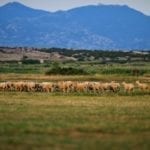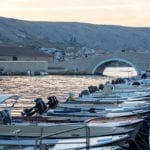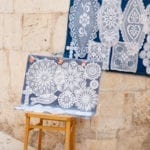Every place has its own peculiarities, and here’s a few you should know about Pag.
Pag cheese and sheep
Pag cheese is one of the most delicious Croatian hard cheeses and is made from milk of Pag island sheep, bred almost exclusively on the island of Pag for their milk. Its unique taste is the result of immortelle and mediterranean herbs that the sheep feed of, as well as the salt deposited on the vegetation due to winds. It takes 5,5 to 7 liters of milk to produce 1 kg of Pag cheese and it can be young or matured. Young cheese will be of a light-yellow color and a fully matured cheese is dark yellow, has a hard granular structure and spicy taste. When you cut it, it should break unevenly.
Thanks to the specific agro-climatic conditions, numerous types of aromatic and medicinal herbs, sheep’s products (milk, cheese and meat) have a special taste. These sheep are modest in food requirements, highly resistant and adaptable to the conditions of Pag’s barren landscape.
Pag lace and Folk costume
The famously intricate but delicate Pag lace is the most beautiful souvenir you can take home from vacation. It was first mentioned in the 15th century, but it is believed the roots of this unique lacework lie in the Greek Mycenae.
Pag women didn’t have any templates on how to create imaginative patterns, but simply the skill of copying the lacework of their mothers and grandmothers, and adding their own one-of-a-kind touch in creating new shapes. What makes it so special, along with artistic value, is that it is made with very fine threads which make it extremely durable. Pag lace is an autochthonous Croatian product, highly sought after and often called white gold. Lace is no stranger to the fashion world, more and more designers are starting to incorporate it into their designs again.
It has been added to UNESCO’s Representative List of the Intangible Cultural Heritage of Humanity.
Pag folk costume is another thing of special beauty. Passed on from generation to generation, it witnesses the great love for cultural and historical heritage. The womens’ costume most recognizable part is called the “pokrivača” – white cloth in the shape of a triangle with a trim embedded with lace. Along the breast of the shirt, longitudinally from the neck to the waist, there is an ornament within the original lace called “paški teg“. The traditional jewelery is a gold necklace, a pendant called the “peružini” in Pag, and large earrings or “ročini” that are more like bells or pearls.
Pag archeological sites
Pag has plenty of historical remnants for archeology buffs.
Back in the 14th century, Pag Old Town was frequently attacked, so the people of Pag started building a new habitat. Today, the Old Town is an archeological site with plenty to explore.
The area of the Caska Bay is particulary interesting for divers. It was once a Roman town called Cissa (Kisa) which, as a consequence of an earthquake, sunk below the sea in the 4th century. Yes, there’s an entire city on the seabed! The legends tells a story about two sisters that resided in Kisa, one good (Bona), and the other one evil (Mala). God sent an angel to Kisa to find one good and pure human among the corrupted population. The angel found Bona, the good sister and told her to flee the city while it sank into the sea in a terrible earthquake. Another legend has a different take on the two sisters. Bona had beautiful, healthy children but lived in poverty, while the evil sister had pale, sickly children but lived in wealth. Bona asked her sister for help, but Mala refused. Go sunk the city, but saved Bona and her children by delivering them to the hilltop St. George.
Another curiosity is the Roman aqueduct dating back from the 1st century and rediscovered in the 19th century. The workmanship on this tunnel is absolutely remarkable. Without any modern tools, it carved out of solid rock, 1.2 km long, with width ranging from 60 to 70 cm.
Pag carnival
The Pag Summer Carnival has a long tradition, in fact, it is the oldest carnival in the Adriatic. It is held the last weekend in July and fills the streets with laughter, dance, joy and the carnival craziness! The carnival starts with a transfer of power, so that the town can be ruled by the carnival parade. The party continues with an abundance of activities, shows, concerts, good food and laughs, so be sure to check it out!
Salt
Pag is also known for the production of sea salt. Its specific microclimate, good wind and a large number of sunny days, help the salt produced in Pag contain all the beneficial minerals of the Adriatic sea. Pag has a long tradition of production in an ecological way, using the energy of the sun and wind, as the sea evaporates in spacious pools.
Come and check out these peculiarities for yourself. Book your vacation at Camping Village Šimuni!



